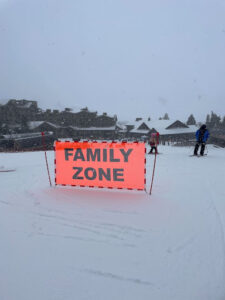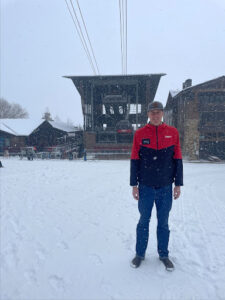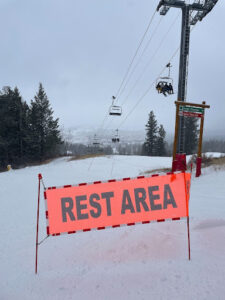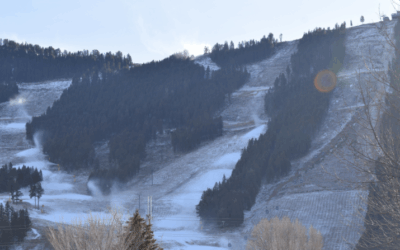It’s the third weekend of the ski season at Jackson Hole Mountain Resort and the first flakes of the season’s first heavy snowfall are floating onto the heads of hundreds at the base. It’s early in the season, only about half the mountain’s lifts are open.
However, just a week prior, a “Destination December” marketing campaign on the mountain broke a world record. With over 3,000 skiers, the resort broke the same record it set last year . This, while only half the resort’s lifts were open.
Liv Vosmus is bundled from head to toe, chewing on her buff as she slides into a lift line alongside her dad, Kyle Vosmus. The family has season passes. They aim to make it to the mountain every weekend.
Kyle’s familiar with the slopes but says he worries about safety “often,” especially as a parent. His biggest concern?
“Fast skiing in slow areas,” Kyle said.

A family zone sign stands near the busy base of the mountain. The signs, placed in congested areas of the mountain, are one of several changes JHMR hopes will improve safety. (Dante Filpula Ankney/KHOL)
That’s exactly what the mountain resort aims to rein in this year with new safety changes.
Changes include new signs with the words “family zone” and “rest area” across the mountain in congested areas, to encourage resort-goers to slow down or take a break. Both are designated along runs by wide, orange signs with large black, bold letters. The new signs are in addition to similar slow zone signs that have been around for years.
Allison and Nick Armitage, and their kids Lexi and Dylan are also season pass holders. Their biggest safety concerns are similarly erratic, fast skiers blowing past signs.
“I think they’re more effective when there is the guy out there with the whistle telling people to slow down,” Allison said.
“Yeah, they’re doing what they can,” Nick said, “but people ski through them really fast.”
This year skiers will also see more of the people with whistles, “speed wranglers,” behind these signs.
“Speed wranglers” or “yellow jackets” — named after their bright coats — are tasked with yelling, signaling or blowing a whistle at speedsters to slow down. They issue warnings and in severe cases, yank passes.
In addition to the slopes, the mountain is upping safety themes in its offices, with a new “safety pledge” issued to all staff, spelling out the importance of their role as ambassadors and their commitment to the “triangle of safety”: reducing speed, giving space and being self-aware. This message and others like it are on posters throughout the resort.
That’s according to Marketing Director Ned Wonson. He says the safety measures are part of the mountain’s year-to-year, season-to-season commitment to improving safety.

JHMR Marketing Director Ned Wonson stands in front of the mountain’s famous tram that has yet to open, due to early season conditions. (Dante Filpula Ankney/KHOL)
“You’ll see it on the tram wall, on the tram dock, in the season pass office and on the lap maps on chairlifts,” Wonson said, “it’s really important to understand.”
It’s a big deal to go skiing in Jackson Hole and it’s a big mountain,” Wonson said. “We’re doing “everything we can to make people aware of all of those things.”
Last year, 71-year-old ski instructor, Peter Wuerslin died after a collision with another skier.
The Jackson Hole News and Guide reported that a group of concerned skiers have been calling for increased safety on the mountain following Wuerslin’s death. A recent poll of the paper’s readership shows many don’t believe the mountain’s new safety measures go far enough.
Wonson says changes are not a reaction to one event.
Ski resorts know safety is not one factor. It’s influenced by the number of people on a mountain, and conditions like ice as well as an individual’s choices. Of those, the factor the resort can best control is numbers of people. Wonson says ticket sales this year are similar to last.

The new “rest area” signs designate spots to the side of the mountain that allow resort-goers to recoup. Factors like tiredness or frustration can impact skier decisions on the mountain and ultimately, safety. (Dante Filpula Ankney/KHOL News)
“There’s always that consideration, right? Whether it’s the available terrain that’s open or expected usage from season passholders,” Wonson said. “All of those things can have an impact on safety, certainly.”
Wonson said the mountain consulted the National Ski Area Association, a member-based ski resort advocacy group to make the changes this year and they’re measuring several metrics to gauge success. Those include passes pulled, incidents and injuries.
“We look at metrics across the industry and try to understand how we measure against those other places,” he said, “and we feel we measure very well in many of those areas.”
But the resort won’t share the data. Wonson says those markers like warnings issued, passes pulled and tickets sold, are private, citing business practice.
This year’s changes throw the resort’s fine line of safety into sharp relief.
On one side, marketing to an ambitious crowd that wants to ski fast and steep. On the other, the importance of catering to and promoting the relaxed, family-friendly, taking-it-easy kind of skiing.
Wonson does not think the two contradict. He said the resort sees it as their “responsibility.”
“We know that we’re known for big mountain skiing and we love that, and we embrace that,” he said. “But we don’t think that enforcing reckless skiing in slower zones plays into that or has a negative impact.”
Though, that doesn’t absolve personal responsibility. JHMR safety changes hinge on a community request.
“Our big ask this year within the community is,” Wonson said, “to be aware of the slow zones, family zones, ski in control, go with the flow of traffic and respect those zones for us.”
While the signs of this year’s safety changes are scattered over the mountain in bright orange and yellow jackets, just how effective they are, will likely remain private.






